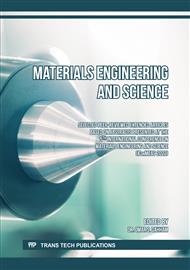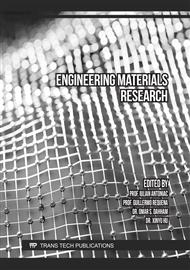[1]
L. Zeng, H. Sun, T. Peng, T. Hui, Effect of glass content on sintering kinetics, microstructure and mechanical properties of glass-ceramics from coal fly ash and waste glass, Mater. Chem. Phys., vol 260 Feb (2021),.
DOI: 10.1016/j.matchemphys.2020.124120
Google Scholar
[2]
K. Johansson, Understanding recycling behavior: a study of motivational factors behind waste recycling, in Waste Management and The Environment VIII, vol. 1 Jun. (2016) 401–414,.
DOI: 10.2495/wm160361
Google Scholar
[3]
M. Y. F. Esraa, Q. Shehab, Z. B. Mohammed, Estimation of the Components of Residential Solid Waste in Baqubah City and their Generation Rate. Engineering and Technology Journal, 39(3) (2021) 440-452.
DOI: 10.30684/etj.v39i3a.1777
Google Scholar
[4]
A. Powęzka, P. Ogrodnik, J. Szulej, M. Pecio, Glass cullet as additive to new sustainable composites based on alumina binder, Energies, vol.14, no. 12, Jun( 2021),.
DOI: 10.3390/en14123423
Google Scholar
[5]
B. Jaiswal, V. K. Singh, S. Mishra, R. K. Verma, Study on polymer (epoxy) composite using carpet waste for lightweight structural applications: A new approach for waste management, Mater. Today Proc., vol. 44(2021) 2678–2684 ,.
DOI: 10.1016/j.matpr.2020.12.681
Google Scholar
[6]
H. S. Fadhil, Flexural and Impact Properties of Epoxy Composites Reinforced with Peanut Shell Particles. Engineering and Technology Journal, 38 (2020) 1026-1033.
DOI: 10.30684/etj.v38i7a.584
Google Scholar
[7]
F. A.Hashim, M. S. Hamza, R. R. Abdullah. Effect of Silica Powder Addition on Mechanical Properties of Polymer Laminate Composite. Engineering and Technology Journal 35, no. 7 Part A (2017).
DOI: 10.30684/etj.35.7a.9
Google Scholar
[8]
G. Vara Prasad, S. Nagappa, Y. Ravi Kanth, I. Gopi Lakshmi, J. Babu Rao, Effect of brachyura shell particles on glass fibre reinforced epoxy polymer composite, Mater. Today Proc., vol. 42, no. xxxx, (2020) 555–562, ,.
DOI: 10.1016/j.matpr.2020.10.521
Google Scholar
[9]
H.Sukanto, W. W. Raharjo, D. Ariawan, J. Triyono, M. Kaavesina. Epoxy resins thermosetting for mechanical engineering. Open Engineering 11, no. 1 (2021) 797-814.
DOI: 10.1515/eng-2021-0078
Google Scholar
[10]
S. S. Asmeeta Jagdeva, B. . Jenab, B. B. Nayakc, Preparation and characterization of Mechanical Properties of Epoxy Resin Composites reinforced with Non Bio-degradable Wastes. Materials Today: Proceedings 5 (2018) 19723–19727.
DOI: 10.1016/j.matpr.2018.06.334
Google Scholar
[11]
R Sahu, M. K. Gupta, R. Chaturvedi, S. S. Tripaliya, A. Pappu. Moisture resistant stones waste based polymer composites with enhanced dielectric constant and flexural strength. Composites Part B: Engineering 182 (2020): 107656.
DOI: 10.1016/j.compositesb.2019.107656
Google Scholar
[12]
A. Agrawal, S. Chandraker, A. Sharma, Physical, mechanical and sliding wear behavior of solid glass microsphere filled epoxy composites, Mater. Today Proc., vol. 29(2018) 420-426,.
DOI: 10.1016/j.matpr.2020.07.295
Google Scholar
[13]
K. Bharadwaja, S. S. Rao, T. B. Rao, Investigation of tensile and flexural behavior of epoxy and SiO2 composite: An experimental study, Mater. Today Proc., vol. 45( 2021) 2649–2652 ,.
DOI: 10.1016/j.matpr.2020.11.514
Google Scholar
[14]
S. H.Aleabi, H. G. Attiya, A. W. Watan. Study of the Diffusion Coefficient and Hardness for a Composite Material when Immersed in Different Solutions Polymer. Engineering and Technology Journal 35, no. Special Issue 1 (2017).
Google Scholar
[15]
A. M. Hameed , R. H. Helal, The Diffusion Coefficients of Different Types of Liquid Environments Into Binary Polymer Blend, Journal of Al-Nahrain University Science, vol. 16, no. 3 (2013) 148–158.
DOI: 10.22401/jnus.16.3.21
Google Scholar
[16]
M. N. A. M. Taib , N. M. Julkapli, Dimensional stability of natural fiber-based and hybrid composites, Mechanical and Physical Testing of Biocomposites, Fibre-Reinforced Composites and Hybrid Composites.( 2018) 61–79.
DOI: 10.1016/b978-0-08-102292-4.00004-7
Google Scholar
[17]
B. K. Ibrahim , F. H. Antar, The study of the bending property of the epoxy (Ep / MgO) and (Ep/SiO2) composites in natural conditions and after immersion in chemical solution. Iraqi Journal of Physics, p. Vol.16, No.39 (2018) 93-102.
DOI: 10.30723/ijp.v16i39.107
Google Scholar
[18]
U. R.Hashim, A. Jumahat, M. Jawaid, R. Dungani, S.Alamery. Effects of accelerated weathering on degradation behavior of basalt fiber reinforced polymer nanocomposites. Polymers 12, no. 11 (2020) 2621.
DOI: 10.3390/polym12112621
Google Scholar
[19]
A. L. AL-Yaour ,A. A. Mohamed, The Abnormal Behaviour of Epoxy Resin in Acidic and Basic Organic Media, Rafidain J. Sci., vol. 20, no. 5 (2009)79–94,.
DOI: 10.33899/rjs.2009.40066
Google Scholar
[20]
N. K. Faheed, J. K. Oleiwi, Q. A. Hamad Effect of Different Fiber Reinforcements on Some Properties of Prosthetic Socket. Engineering and Technology Journal 39, no. 11 (2021): 1715-1726.
DOI: 10.30684/etj.v39i11.2267
Google Scholar
[21]
M. J.Kadhim , H. M. Kamal, L. M. Hasan. The wear characteristics of thermoset polymers composites filled with ceramic particles. Journal of Mechanical Engineering Research and Developments Vol. 44, No. 3,(2021) 322-333.
Google Scholar
[22]
H. H. Shukur. Effect of glass addition and heat treatment on mechanical properties and wear rate of aluminum-2% graphite." Diyala journal of engineering sciences10, no. 4 (2017) 33-41.
Google Scholar
[23]
M.Sayer, Elastic properties and buckling load evaluation of ceramic particles filled glass/epoxy composites. Composites Part B: Engineering 59 (2014) 12-20.
DOI: 10.1016/j.compositesb.2013.11.016
Google Scholar
[24]
R.A.K. Abbas, Study of the thermal effect on the mechanical properties of a hybrid composite, vol. 1. (2007).
Google Scholar



